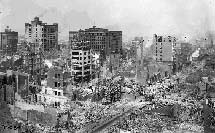
Handy Links
SLAC News Center
SLAC Today
- Subscribe
- Archives: Feb 2006-May 20, 2011
- Archives: May 23, 2011 and later
- Submit Feedback or Story Ideas
- About SLAC Today
SLAC News
Lab News
- Interactions
- Lightsources.org
- ILC NewsLine
- Int'l Science Grid This Week
- Fermilab Today
- Berkeley Lab News
- @brookhaven TODAY
- DOE Pulse
- CERN Courier
- DESY inForm
- US / LHC
SLAC Links
- Emergency
- Safety
- Policy Repository
- Site Entry Form

- Site Maps
- M & O Review
- Computing Status & Calendar
- SLAC Colloquium
- SLACspeak
- SLACspace
- SLAC Logo
- Café Menu
- Flea Market
- Web E-mail
- Marguerite Shuttle
- Discount Commuter Passes
-
Award Reporting Form
- SPIRES
- SciDoc
- Activity Groups
- Library
Stanford
Around the Bay
Earthquake Safety
 One hundred years ago today, San Francisco experienced an estimated 7.9 magnitude earthquake.
Gas lines broke, 60 fires broke out, and the water system failed. More than 3,000 people perished and
29,000 buildings were razed in the disaster, a combination of the quake and the fires that lasted for
three days.
One hundred years ago today, San Francisco experienced an estimated 7.9 magnitude earthquake.
Gas lines broke, 60 fires broke out, and the water system failed. More than 3,000 people perished and
29,000 buildings were razed in the disaster, a combination of the quake and the fires that lasted for
three days.
The quake was on the San Andreas Fault—which lies just a quarter mile away from SLAC's western border. Modern technology in construction and building has improved greatly since 1906, and we are safer now then they were back then. However, we should still be prepared in the event of an earthquake.
The SLAC Emergency Response Team (SERT) prepares for earthquake safety on site through planning and drills. Supply trailers are located in strategic locations around the site and SLAC's buildings are constructed with modern safety standards. They are also reviewed by the Earthquake Safety Committee (a Citizen's Committee). Maintenance and engineering groups regularly perform safety work to protect offices and equipment from the effects of quakes. Everybody at SLAC works hard to make sure we are as safe as we can be.
What can we personally do for earthquake safety? A few basic things we all can do, both here and at our homes, are:
Earthquake Preparation
- Brace and secure all furniture in your office and home. Here at SLAC, you can place a maintenance request at CEF to have this done.
- Place large or heavy objects on lower shelves. Fasten shelves, mirrors, and large picture frames to walls. Brace high and top-heavy objects.
- Store any breakable items (glass, ceramics, etc.) on low shelves or in cabinets that fasten shut.
- Locate safe spots in each room under a sturdy table or against an inside wall.
- Participate in SLAC's regular earthquake drills in your building and know your evacuation routes. Talk to your Building Manager for details. At home, hold periodical drills with your family.
During an Earthquake
- Minimize your movements during an earthquake by knowing the closest safe space. Stay indoors until the shaking has stopped and you are sure exiting is safe.
- If you are indoors, take cover under a sturdy desk, table, or bench and hold on. If there isn't a table or desk near you, cover your face and head with your arms and crouch in an inside corner of the building.
- Stay away from glass, windows, outside doors and walls, and anything that could fall, such as lighting fixtures or furniture.
- Stay inside until the shaking stops and it is safe to go outside. Most injuries during earthquakes occur when people are hit by falling objects when entering or exiting buildings.
- Be aware that the electricity may go out or the sprinkler systems or fire alarms may turn on.
- If you are outdoors, stay there. Move away from buildings, streetlights, and utility wires. At SLAC, go to the nearest evacuation staging area. If you are in a moving vehicle, stop as quickly as safety permits and stay in the vehicle. Avoid stopping near or under buildings, trees, overpasses, and utility wires.
- Proceed cautiously once the earthquake has stopped, watching for road and bridge damage.
After an Earthquake
- Be prepared for aftershocks. These secondary shockwaves are usually less violent than the main quake but can be strong enough to do additional damage to weakened structures.
- Open cabinets cautiously. Beware of objects that can fall off shelves.
- Stay away from damaged areas unless your assistance has been specifically requested by police, fire or relief organizations.
For more information on Earthquake Safety at SLAC, please contact Fire Marshall Robert Reek or Assistant Fire Marshall Ralph Kerwin.
(Safety information adapted from the FEMA website "Are You Ready.")
—Larissa Williams SLAC Today, April 18, 2006